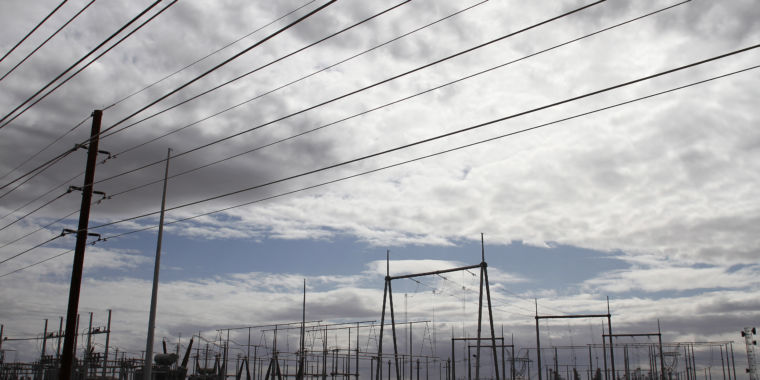

/ A switch yard that receives electricity from photovoltaic solar panels in Yuma County, Arizona.
Joshua Lott/Bloomberg via Getty Images
Last week, Arizona Public Service (APS) announced that it would procure 850 megawatts (MW) of battery storage by 2025. APS, which is the largest utility in the southwestern state, also said it would add at least 100 MW of solar power to its grid by 2025.
According to Utility Dive, 450 MW of that battery storage will be deployed by 2021, with a total of 1200 megawatt-hours (MWh) of energy. The additional 400 MW will be built before 2025, but the duration of those batteries is not yet confirmed. APS’s statement notes that the new battery capacity will be built at existing solar plants.
The announcement is one of the largest made by a utility for battery storage. In July of last year, California’s PG&E signed similarly large deals with Tesla, Vistra/Dynegy, and Hummingbird Energy Storage. Invenergy and AES will work with APS to provide the batteries in Arizona.
According to APS, the 100 MW of new solar that will be built will be paired with 100 MW / 300 MWh of battery storage from the 2021 pool of deployments.
In a statement, APS Chairman and CEO Don Brandt said that the new storage additions will be used to extend the duration of renewable energy into the high-demand evening hours. “Arizona is already a national leader in solar energy. The challenge is, no one has figured out how to stop the sun from setting at night. As storage technology improves and declines in cost, we will increasingly be able to store the power of the sun cost-effectively to deliver when our customers need it.”
Arizona has been trying to leverage the power of the sun during those hot afternoon and evening hours for years. As early as 2013, the Soluna solar thermal plant was built with molten salt tanks to store the heat reflected from fields full of mirrors for up to six hours. But the cost of photovoltaic solar panels have been falling much more rapidly than the cost of concentrated solar power, and utilities have been eager to cash in.
Interestingly, APS also announced a new Power Purchase Agreement (PPA) with a 463 MW natural gas plant owned by Calpine. But APS noted in its statement that “instead of a traditional 20-year contract, the purchase agreement with Calpine is seven years, allowing APS the flexibility to take advantage of cleaner technologies in the future as they mature.”









